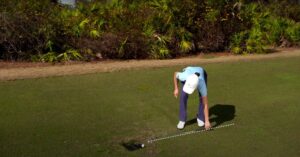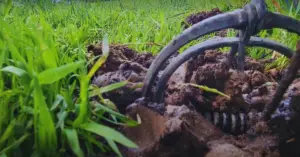How To Get A Golf Ball Out Of A Drain? [Easy Guide]
Picture this: you’re on the golf course, enjoying a beautiful sunny day, when suddenly, your well-struck shot takes an unfortunate turn and lands right in a drain. It’s a frustrating moment that every golfer has likely experienced at some point.
When it comes to retrieving a golf ball from a drain, one of the simplest and most effective methods is using a golf ball retriever. These extendable devices, equipped with a basket or scoop at the end, allow you to reach into the drain and secure the ball without the need for direct physical contact.
So, if you’re facing this predicament and wondering how to reclaim your lost ball, read on to discover some handy tips that can save the day.
How To Get A Golf Ball Out Of A Drain?
Retrieving a golf ball from a drain can be a challenging task, but there are multiple methods you can try. Here’s a step-by-step guide outlining three different approaches you can use:
Method 1: Using a Retriever Tool or Grabber
- Before attempting to retrieve the golf ball, assess the drain and its surroundings to ensure it is safe to proceed.
- Collect a retriever tool or grabber with a long reach. These tools are specifically designed for reaching into tight spaces.
- Extend the retriever tool or grabber fully, making sure it is securely locked in place.
- Carefully insert the tool into the drain, aiming to position it beneath or around the golf ball.
- Close the retriever tool or grabber to grip the golf ball securely.
- With a firm grip on the ball, gently and slowly pull it out of the drain.
Method 2: Creating a DIY Fishing Line or Wire Loop
- Ensure the drain and its surroundings are safe and accessible before attempting retrieval.
- Collect a long, sturdy fishing line or flexible wire that can fit into the drain.
- Create a small loop at the end of the fishing line or wire. This loop will be used to catch and retrieve the golf ball.
- Insert the fishing line or wire into the drain and maneuver it carefully to position the loop around the golf ball.
- With the loop positioned around the ball, gently pull and maneuver the line or wire to hook onto the ball securely.
- Slowly and steadily pull the fishing line or wire, bringing the ball out of the drain.
Method 3: Utilizing a Shop Vacuum or Wet/Dry Vacuum
- Ensure the drain is safe and accessible, and check if a shop vacuum or wet/dry vacuum can be used for retrieval.
- Retrieve a shop vacuum or wet/dry vacuum that has a hose attachment and is capable of handling debris.
- Attach the hose of the vacuum to the appropriate opening or nozzle.
- Position the hose near or over the golf ball, ensuring a secure and airtight connection.
- Turn on the shop vacuum or wet/dry vacuum to create suction that will draw in the golf ball.
- Allow the vacuum to draw in the ball until it is securely trapped in the vacuum’s container or filter.
Remember to exercise caution during the retrieval process, and if any method seems ineffective or risks damaging the drain or golf ball, it is advisable to seek professional assistance.
How To Tell If A Golf Ball Is Waterlogged?
Determining whether a golf ball is waterlogged is crucial for its performance. Waterlogged balls can affect distance and accuracy. Here’s how you can tell if a golf ball is waterlogged:
Visual Inspection
Begin by visually inspecting the golf ball for any signs of water damage or saturation. Look for visible cracks, indentations, or a discolored appearance.
Check for Weight Variations
Pick up the golf ball and compare its weight to that of a dry ball of the same brand and model. If the ball feels significantly heavier, it may indicate water absorption.
Listen for Sloshing Sounds
Gently shake the golf ball close to your ear. If you hear a sloshing or rattling sound, it suggests that water has penetrated the inner core.
Perform the Float Test
Fill a container with water and carefully drop the golf ball into it. A waterlogged ball will sink or remain partially submerged due to the water it has absorbed. In contrast, a properly intact ball will float.
Assess Bounce and Feel
Take the golf ball to a flat surface and bounce it gently. A waterlogged ball may exhibit reduced bounce compared to a dry ball. Additionally, a waterlogged ball may feel softer or less responsive when squeezed.
Conduct a Spin Test
Place the golf ball on a flat surface and give it a firm spin with your hand. Observe if the ball wobbles or doesn’t spin smoothly, as this can be an indicator of waterlogged internals affecting balance and performance.
9 Tips for Avoiding Golf Ball Drain Incidents
To avoid golf ball drain incidents and the frustration of retrieving them, consider the following tips:
1. Assess the Layout of the Course
Familiarize yourself with the layout of the course, paying attention to any areas where drains or water hazards are present. This knowledge will help you strategize your shots and avoid aiming toward such areas.
2. Choose Your Shots Wisely
Before taking a shot, evaluate the potential risks and hazards in your vicinity. Aim away from drains, water hazards, or any areas where the ball may easily roll into drains or other challenging locations.
3. Play Conservatively Near Hazards
When playing near drains or water hazards, consider taking more conservative shots. Opt for higher lofted clubs or shorter shots that minimize the risk of the ball rolling or bouncing into hazardous areas.
4. Use Alignment Aids
Utilize alignment aids such as aiming markers or target flags to ensure your shots are directed away from potential drain areas.
5. Play with Distance Control
Maintain control over your shots by focusing on distance control. Aiming for a consistent and appropriate distance can help you avoid overshooting or undershooting the target area.
6. Carry Extra Golf Balls
Always have extra golf balls with you in case you lose one or it ends up in a drain. Having replacements readily available allows you to continue your game without significant interruptions.
7. Stay Alert and Watch Your Shots
Keep a watchful eye on your shots, especially if they are heading toward potential drain areas. By remaining attentive, you can react quickly and take necessary precautions to avoid losing your ball.
8. Play with a Spotter
When playing in a group, designate a spotter to keep an eye on shots near drain areas. The spotter can help track the ball’s trajectory and provide guidance to avoid any potential hazards.
9. Follow Course Etiquette
Adhere to the course’s rules and etiquette. Respect the boundaries and designated play areas, and avoid taking unnecessary risks that may increase the chances of your ball ending up in a drain.
Frequently Asked Questions
In this section, we address common concerns and provide practical solutions for the challenging task of retrieving a golf ball from a drain. Explore these FAQs for helpful guidance and tips.
Is It Safe To Use Chemicals To Dissolve The Golf Ball?
No, it is not recommended to use chemicals as they may cause damage to the drain or surrounding pipes. Stick to non-invasive methods like using tools or water to retrieve the ball.
Are There Any Diy Methods To Retrieve The Golf Ball?
Yes, you can try using a vacuum cleaner with a hose attachment. Insert the hose into the drain and create suction to pull out the ball. Ensure the vacuum cleaner is suitable for wet materials.
Should I Dismantle The Drain To Retrieve The Golf Ball?
Dismantling the drain should be the last resort. It is recommended to call a professional plumber who has the necessary tools and expertise to dismantle and reassemble the drain without causing further damage.
Can I Use A Wire Coat Hanger To Fish Out The Golf Ball?
Yes, straighten out a wire coat hanger and create a small hook at the end. Gently insert it into the drain and try to hook the ball. Be careful not to scratch or damage the drain or pipes.
What Precautions Should I Take To Prevent Golf Balls From Entering The Drain?
To avoid future incidents, set up protective barriers like a mesh screen or grate over the drain to catch any stray golf balls.
Additionally, practice caution while playing near drains and be mindful of where your shots are aimed.
Conclusion
When it comes to rescuing a golf ball from a drain, having a golf ball retriever can be a game-changer. This simple tool allows you to retrieve your lost ball without any hassle safely.
Remember to prioritize your safety and seek assistance if necessary. So, next time you find yourself in this predicament, don’t fret—just reach for your trusty retriever and save the day.






